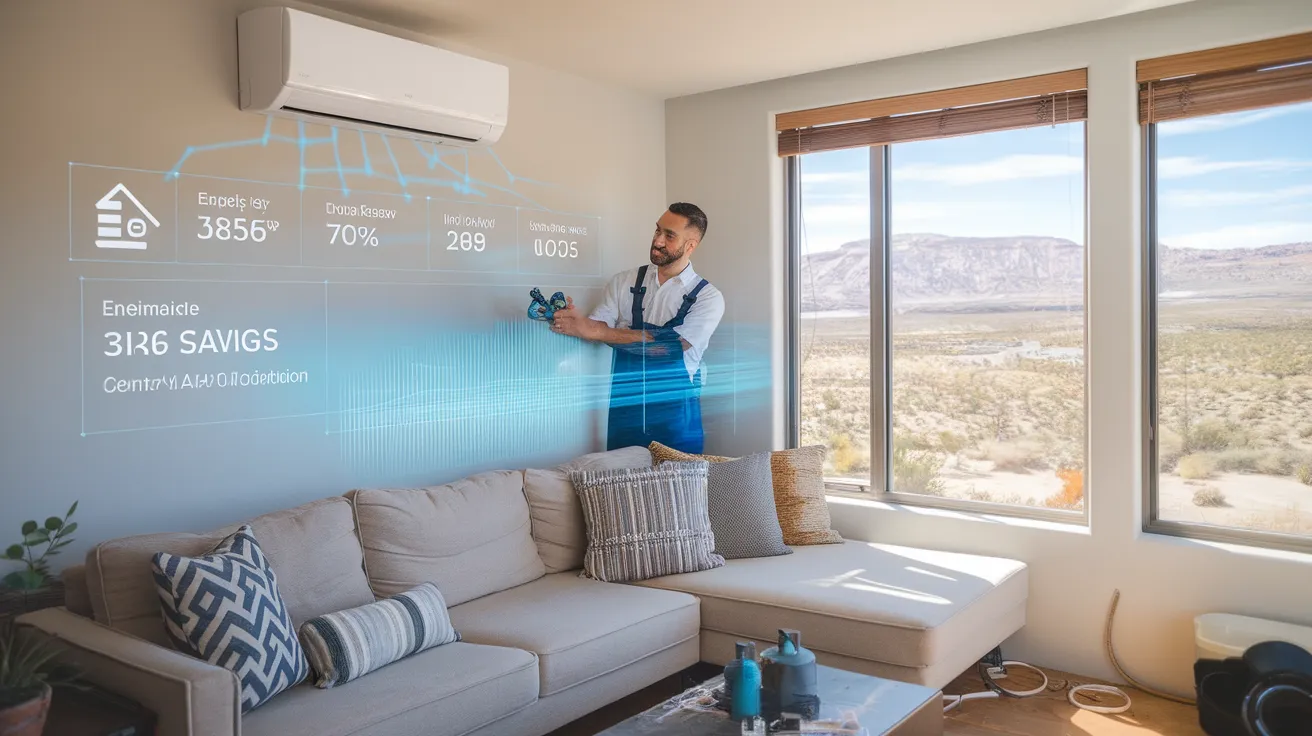Keeping cool in the Southern Utah heat can be economical and energy-conscious. Emphasize effective insulation, intelligent temperature control, and scheduled AC servicing. Take advantage of passive cooling, shade your windows, and evaluate the perks of energy efficient ductless systems. Don't overlook the importance of smart landscape design, such as carefully positioned trees and cooling ground surfaces, which can reduce heat absorption. Ready to explore the nitty-gritty of converting your home into a warm-weather retreat without maxing out your AC and breaking the bank? Keep reading!

Main Takeaways
Getting to Know the Principles of Cost-Effective Air Conditioning
While you might think that cranking up the air conditioner is the sole solution to cool your living space during summer, learning about the basics of energy-efficient cooling will give you new insights. It's not just about comfort, it's additionally about energy conservation. Keep in mind that cooling techniques like insulation, shading, and ventilation can significantly decrease your energy usage. By adding proper insulation, you're stopping cool air from escaping, thereby reducing the need to continuously run your AC. Shading your windows, especially those facing the sun, can minimize heat buildup. And ventilation, whether natural or mechanical, helps circulate air, keeping your home cool. A more energy-efficient home isn't only cost-effective, it's environmentally-friendly too.
Choosing the Ideal Air Conditioning System
Understanding energy-efficient cooling methods is an excellent starting point. But selecting the right air conditioning system is key to optimize these strategies. Selecting between central and ductless is an important consideration. Central air provides whole-house cooling, while ductless systems target individual zones. Both options have their benefits, but ductless units often save more energy if you don't use all rooms regularly. Check the energy ratings when deciding on a unit. Better ratings mean more energy savings, but typically require larger initial investment. It requires careful consideration, but investing in high-efficiency equipment will save money long-term. Keep in mind, the right choice helps handle that Southern Utah heat efficiently.
The Impact of Insulation in Keeping Your Home Cool
While you might not immediately consider it, proper insulation plays a crucial role in regulating indoor comfort during the warmest times of the year. Insulation materials work by providing thermal resistance, slowing the rate of heat transfer from your indoor space to the scorching outdoors. This shows that the conditioned air created by your air conditioning system is retained more effectively, easing the load on your AC unit and saving you money on energy bills. It's essential to select insulation with a high R-value, which signifies greater thermal resistance. From spray foam to fiberglass, the right insulation can make a significant impact in your home's summer comfort and energy efficiency.
Maximizing the Power of Natural Airflow
You can utilize natural ventilation to keep your home cool and decrease your energy bills. By knowing how it works, you can get the most from the advantages of cross-ventilation throughout daylight hours. Moreover, implementing a nighttime ventilation strategy can deliver significant cooling results when temperatures decrease.
Natural Ventilation Explained
Although it might appear complex, understanding natural ventilation is actually quite simple. The focus is on controlling the natural flow of air in your home to maintain comfort while minimizing reliance on high-energy air conditioning. The secret is knowing the right time to open your windows and doors to welcome cooler air, and the right time to close them to prevent warm air from entering. You'll need to learn about various ventilation methods that can optimize airflow, such as placing fans effectively and creating pathways for air to flow naturally. By leveraging the power of natural ventilation, you're not only maintaining a comfortable home, you're also supporting a more sustainable future.
Optimizing Cross-Ventilation Advantages
To maximize the potential of the power of natural ventilation, it's crucial to optimize the benefits of cross-ventilation. This calls for carefully positioned windows and utilizing cross ventilation strategies. When installing windows, choose those that face different directions. This provides a channel for air to flow freely in and out of your home, resulting in natural temperature regulation.
Additionally, you can improve this ventilation by opening adjacent windows. This encourages a cross breeze that can substantially reduce indoor temperatures. To maximize the benefits, verify that the windows are free from obstructions, both indoors and outdoors, such as household items or vegetation. By considering these aspects, you're optimizing natural ventilation and lowering your need on energy-intensive cooling systems.
Nighttime Ventilation Strategy
While summer days might feel blazing hot, nighttime usually provide a revitalizing coolness that you can utilize to your advantage. Here's where a nighttime ventilation approach proves useful. By harnessing the advantage of natural airflow, you can achieve effective nighttime cooling and enhanced air circulation.
Start by propping open windows and doors when the outside temperature falls below the inside temperature. This facilitates cool air to flow in and drive the warm air out, creating a natural air circulation. Then, as morning nears and the temperature begins to rise, secure everything up to retain the cool air inside. Applying this basic but efficient strategy can bring about a significant difference in maintaining a cozy and energy-efficient home during the scorching Southern Utah summers.
Understanding AC Maintenance Importance
Many people don't know, but routine air conditioning service plays a pivotal role in preventing system overloads during those scorching summer months. Not only does it boost your AC's functionality, but it's also critical for maximizing the system's longevity. Here's why what makes this crucial to your household's power consumption.
Avoiding System Overloading
While summer heat can drive your AC system to its limits, consistent servicing can help stop system breakdowns. Compare your AC similar to a car. Would you begin a cross-country drive without checking the oil, right? The same goes for your AC unit. Scheduled inspections can keep it running smoothly, minimize the likelihood of malfunctions, and contribute to more info energy savings.
Proactive measures involve changing filters every month, cleaning the coils, and verifying sufficient refrigerant. Ignoring these crucial tasks can result in system inefficiency, forcing your air conditioning unit to operate inefficiently and increase energy usage. Therefore, maintain your AC properly. Consistent system care doesn't just helps prevent system overloads but additionally prolongs its lifespan.
Maximizing Air Conditioner Operation
To guarantee your AC runs at optimal levels, regular maintenance must be a top priority. Neglecting this can lead to reduced performance and increasing bills. Avoid this situation. AC optimization strategies include routinely maintaining filters, making sure your system operates efficiently.
Making improvements to your cooling system is valuable. Installing a programmable thermostat enables you to adjust temperature settings, reducing energy consumption when the house is empty. It's also worth considering fixing leaky ductwork. Up to 30% of your air conditioning can be lost through duct leakage.
To ensure optimal AC performance, you'll need to maintain regular maintenance and evaluate system enhancement options. Your reward will be a cooler home and reduced energy costs throughout the summer season.
Extending Equipment Lifespan
In addition to the direct benefits of reduced energy consumption and financial advantages, consistent AC maintenance is essential in prolonging the durability of your unit. Regular system upkeep goes beyond fixing problems as they arise; it's about stopping them before they happen. By consistently cleaning and inspecting your AC system, you reduce wear and tear, enhance operation, and extend its lifespan. Consider it an investment in lifespan extension. Keep in mind, a properly serviced AC unit performs more efficiently it has extended durability. So, don't neglect regular maintenance. It'll ensure optimal system performance, save you money in the long run, and help you handle the Southern Utah heat efficiently and effectively.
The Smart Thermostat: Revolutionizing Energy Efficiency
When looking for a practical approach to energy conservation this summer, a smart thermostat may be the game changer you need. Being able to memorize your daily habits and optimize temperature control, it surpasses conventional thermostats. The perks of a smart thermostat transcend simple convenience. By installing one, you're making an informed decision to boost energy conservation in your home, and this generates significant energy savings. You can also operate remotely it through an app, giving you even more flexibility. Fundamentally, a smart thermostat offers comprehensive management of your home's energy use, keeping you comfortable in the Southern Utah heat without excessive costs.
Smart Landscaping Strategies for Enhanced Cooling and Energy Savings
Although a smart thermostat is an impressive method of managing energy use in your home, an additional approach comes from smart landscaping. Planting shade trees along the south and west sides of your home will lower your air conditioning needs substantially. These leafy giants act as protective elements against the sun's heat, promoting outdoor cooling.
Consider adding xeriscaping plants to your yard. These water-efficient species demand minimal water, conserving this precious resource. Moreover, their natural capacity to thrive in warm conditions helps create a more temperate environment.
In conclusion, avoid using dark, absorbent materials for patios or walkways. Select reflective surfaces as an alternative. These surfaces reflect the sun's rays, helping decrease heat around your home and boosting your energy efficiency.
Popular Questions
How Does Humidity Impact Energy-Efficient Cooling Across Southern Utah?
Humidity affects how efficiently your cooling system operates. When the air is humid, your system works harder to cool it, resulting in increased energy consumption. For this reason, installing a dehumidifier can help reduce your AC's workload and lower your energy bills.
What Are Some Energy-Efficient Alternatives to Air Conditioning?
You can consider ceiling fans and evaporative coolers as eco-friendly options to air conditioning. These options are efficient, consume less power, and reduce your energy footprint. It's a practical, budget-friendly approach for maintaining comfort in Southern Utah.
Can You Use Solar Power for Energy-Efficient Cooling
Indeed, you are able to use solar power for efficient cooling. Solar cooling systems utilize solar panel capabilities to energize your cooling requirements, making it a green, budget-friendly solution to traditional air conditioning.
How Do Outdoor Temperatures at Night Affect Energy Efficiency?
When nighttime temperatures fall, you have a chance to boost energy savings. Let the cool night air in by opening windows, which helps reduce air conditioning needs. Remember that strategically controlling overnight temperature drops is a smart approach to temperature changes.
Tax Benefits Available When Installing Energy-Efficient Cooling Systems
You can qualify for tax breaks when putting in eco-friendly cooling solutions. Check out local and federal programs for installation incentives. It's a smart way to lower your investment while reducing your environmental impact and summer cooling bills.
In Conclusion
You're ready to tackle the Southern Utah heat this summer! Keep in mind, an energy-efficient cooling system is easier to achieve than finding a snowball in the desert. With an efficient AC, quality insulation, adequate ventilation, regular maintenance, a programmable thermostat, and thoughtful landscaping, you can maintain a cool, relaxing home without excessive costs. You're conserving energy and, you're making a important step towards sustainable living.
 Danny Tamberelli Then & Now!
Danny Tamberelli Then & Now! Angus T. Jones Then & Now!
Angus T. Jones Then & Now! Michael Jordan Then & Now!
Michael Jordan Then & Now! Pauley Perrette Then & Now!
Pauley Perrette Then & Now! Terry Farrell Then & Now!
Terry Farrell Then & Now!